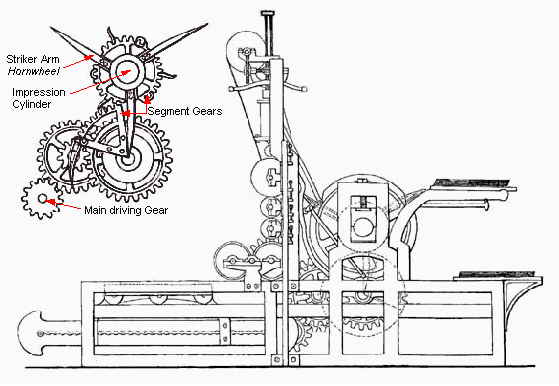 |
 |
 |
 |
 |
 |
 |
 |
 |
 |
 |
|
|
|
|
|
|
|
|
|
|
|
|
|
|
|
KOENIG: his first Powered Printing Machines 1803 - 1818 (continued)
|
|
|
|
|
|
|
|
|
|
|
The Single Cylinder Machine (for bookwork)
* STOP-CYLINDER PRINCIPLE *
|
|
|
|
|
|
|
|
|
|
__Koenig's thoughts now turned to employing a cylinder to take the impression from the forme instead of a platen. His idea was to print the sheet whilst held to the cylinder, thereby making it, as it were, part of the periphery. The printing cylinder was divided into three identical segments, each with a cloth packing and points, in the manner of a hand press tympan, the three segments were capable of separate actions; 1. Laying-on; 2. Printing; 3. Taking-off. Three self-opening and closing frisket frames with spring-loaded tensioning tapes were hinged to the leading edge of each tympan to hold sheets firmly. The cylinder made one-third of a revolution for each impression and then stopped whilst the bed carriage returned and the forme re-inked, at the same time allowing a fresh sheet to be laid on and delivering that already printed. The short cylinder motion, coupled to a much longer bed motion was effected by a somewhat complex arrangement of gears and striker arms, described by Bauer as 'segment wheels and horn-wheels' (below).
|
|
|
|
|
|
|
 |
|
|
|
|
__But the most novel feature, especially for the time, was the ingeniously contrived bed drive mechanism (below). This comprised a continuously revolving pinion wheel turning on a universal-jointed shaft and meshing with a toothed rack attached to the underside of the bed. Two complete revolutions of the pinion moved the bed in one direction. As the pinion reached the end of the rack, part of it engaged itself into a segment, which action caused the pinion to swivel around a stud at the very end of the rack in one half a revolution to then engage the underside of the rack to reverse the direction. These segments, made from the hardest steel engaged the 'tumbler' pin attached to the pinion wheel which, while rotating, caused the bed to slow, stop, and then accelerate in the opposite direction. The slowing down of the bed was also aided by spring buffers affixed at each end of the machine. Koenig utilized his leather-clad rollers, but they were not very reliable due to the sewn joint and their poor ink transfer qualities. Ink was stored in a vertical cylinder and forced out by screw pressure through a fine slit and onto a distributor roller.
|
|
|
|
 |
|
|
|
|
|
|
|
|
|
 |
|
|
|
|
|
__After some experiments, plans were drawn up and a patent was taken out on October 30th, 1811. The new machine was completed in December, 1812. The first sheets printed entirely from cylindrical pressure, were sheets G & X of Clarkson's 'Life of Penn'. Koenig, writing in 1814, stated: 'sheet M of Acton's "Hortus Kewensis," vol. V., will show the progress of improvements in the use of the invention. All-together, there are about 160,000 sheets now in the hands of the public, printed with this machine, which, with the aid of two hands, takes off 800 impressions in the hour.' He also admitted the great benefit he derived from the assistance of his colleague, Bauer. 'By their judgement and precision', he said, 'with which he executed my plans, he greatly contributed to my success.' In the meantime, other well known London printers, Messrs. Taylor and Woodfall had joined Koenig and Bensley in the partnership arrangement.
|
|
|
|
|
|
__Mr. J. Walter, proprietor of the 'London Times,' was very impressed on viewing the single cylinder machine at its first viewing, with its unusual speed and great regularity; but he wanted a faster newspaper machine. Koenig however, briefly explained the more rapid action of a double machine [double-ender or twin feeder] which he had recently patented. Walter, then ordered two larger format double machines, at a cost of £1400 each, for his newspaper. Here at last, was the opportunity for a triumphant issue out of Koenig's difficulties - and obviously good news for the four anxious partners!
|
|
|
|
|
|
|
|
|


